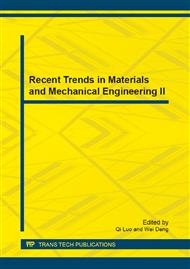p.78
p.85
p.92
p.99
p.107
p.114
p.118
p.123
p.129
Preparation and Properties of Poly(lactic Acid) Fiber Reinforced PHBV Composite
Abstract:
Purposes: This study is to improve the mechanical properties and machinability performance of PHBV. Procedures: PLA/PHBV composites were prepared by dry blend in the melt mixing. The contents of PLA fiber in PHBV matrix are 0, 1, 3, 5, 8 and 10 wt. %. Methods: PLA/PHBV composites were subjected to mechanical property, thermal and morphology evaluation. Results: The results showed the immiscibility of PLA fiber and PHBV matrix. The excellent mechanical properties of the composite (the content of PLA fiber is 8 wt. %) were higher than those of neat PHBV. The micrograph of the fracture surfaces showed that the addition of PLA fiber evidently improved the toughness of PLA/PHBV blends and showed a broad spectrum of PLA fiber diameter (about 200 nm). Conclusions: The improvements were due to the efficient of the PLA fiber as the reinforcement. And the blends showed a significant ductile plastic deformation. The PLA/PHBV blends can be used for a wide range of multifunctional biomedical materials such as the internal fixation of fracture.
Info:
Periodical:
Pages:
107-113
Citation:
Online since:
September 2013
Price:
Сopyright:
© 2013 Trans Tech Publications Ltd. All Rights Reserved
Share:
Citation:


